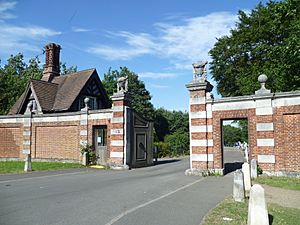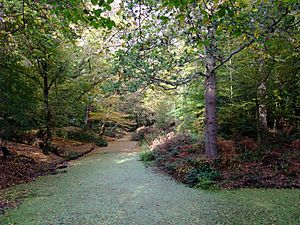Trent Park facts for kids
Quick facts for kids Trent Park |
|
|---|---|
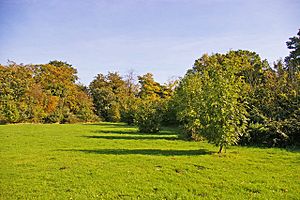
Looking east in Trent Park from near the entrance opposite Oakwood Station.
|
|
| Type | English country house and country park |
| Location | Cockfosters, London, UK |
| Area | 320 hectares (3.2 km2) |
| Created | 14th century (as parkland) |
| Operated by | London Borough of Enfield |
| Status | Open all year |
| Public transit access | Oakwood and Cockfosters |
Trent Park is a large English country house and its beautiful grounds in north London. It's a special place with a long history, and many of its buildings and features, like the house itself and the Orangery, are protected because they are so old and important. The park is also part of a "Green Belt" area, which means it's kept natural and open.
For many years, until 2012, Trent Park House and the buildings next to it were part of Middlesex University. Students studied subjects like performing arts, teaching, and science there. After the university moved out, the site was bought by a developer. They plan to build homes, but the historic buildings, gardens, and landscape will stay. The main house will even have a museum on its lower floors! The parkland, which is about 3.2 square kilometers (320 hectares), has been known as Trent Country Park since 1973. It has a sports ground called Southgate Hockey Centre.
Contents
A Look Back: Trent Park's History
Trent Park has been around since the 1300s. Back then, it was part of Enfield Chase, a huge hunting ground for King Henry IV.
How Trent Park Got Its Name
In 1777, King George III gave the land to his favorite doctor, Sir Richard Jebb. This was a thank-you for saving the life of the King's younger brother, the Duke of Gloucester. Dr. Jebb chose the name "Trent" because the King's brother had been saved in a town called Trent in Italy. After Dr. Jebb passed away, the property was sold to Lord Cholmondeley.
New Owners and Famous Guests
Around 1836, a banker named David Bevan bought the house for his son, Robert Cooper Lee Bevan. Robert built a church nearby in 1838. Later, in 1909, the estate was sold to Sir Edward Sassoon. His son, Philip Sassoon, inherited Trent Park in 1912. Sir Philip was known for being an amazing host. He invited many famous people to Trent Park, including Charlie Chaplin and Winston Churchill.
Trent Park House: A Place for Parties and Secrets
Sir Philip Sassoon loved to entertain. He had the old Victorian parts of Trent Park House changed between 1926 and 1931, making it look like a grand early Georgian-style mansion. It became a very special place, known for its luxury and fun. Imagine famous people like Winston Churchill and George Bernard Shaw chatting over tea, or the Duke of York (who later became King George VI) playing golf! It was a place where important people could relax and enjoy themselves.
Trent Park During World War II
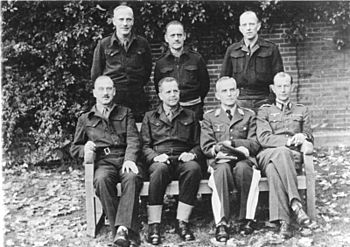
Back row from left to right: Generalleutnant Otto Elfeldt, Generalleutnant Ferdinand Heim, Generalmajor Gerhard Bassenge
Front row from left to right: Generalleutnant Friedrich Freiherr von Broich, General der Panzertruppe Heinrich Eberbach, Generalleutnant Georg Neuffer, Oberst Hans Reimann
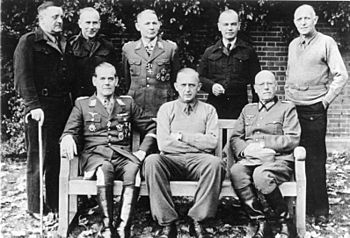
Back row from left to right: General der Infantrie Dietrich von Choltitz, Oberst Gerhard Wilck, General der Fallschirmtruppe Hermann-Bernhard Ramcke, Generalmajor Kurt Eberding, Oberst Eberhard Wildermuth
Front row from left to right: Generalleutnant Rüdiger von Heyking, Generalleutnant Karl-Wilhelm von Schlieben, Generalleutnant Wilhelm Daser
When Sir Philip Sassoon died in 1939, the government took over Trent Park for use during World War II. It became a secret center where the British gathered information from captured German officers.
At first, in 1940, captured German pilots from the Luftwaffe (German air force) were held there. The rooms at Trent Park had hidden microphones. This allowed the British to secretly listen to the pilots' conversations. They learned important things about German aircraft and their strengths and weaknesses.
Later in the war, Trent Park was used as a special prisoner-of-war camp for captured German generals and high-ranking officers. The British treated them well, giving them special food and drinks like whisky, and letting them walk in the park. But the hidden microphones were always listening! This helped the British military (MI19) learn a lot about the German military leaders.
For example, they found out about a secret German rocket development site at Peenemünde Army Research Center when a general talked about it. This led to the Royal Air Force (RAF) bombing that area. The British also learned about war crimes and even about a group in Germany trying to assassinate Hitler. Over 80 German generals were brought to Trent Park.
By the end of the war, more than 1,300 secret recordings had been made. Some of these were published in a book called Tapping Hitler's Generals. Parts of the recordings were also used in a TV series.
From College to Homes

After the war, in 1947, Trent Park became a college for male teachers. In 1950, it became the Trent Park College of Education. The entire estate was bought by Middlesex County Council in 1951 to keep it as Green Belt land. In 1973, Trent Country Park was opened to the public.
The college later became part of Middlesex University in 1992. The university used the site until 2012. In 2015, the house and 50 acres of land were sold to a housing group. People who loved Trent Park wanted a museum in the house, and they succeeded! A museum will be part of the new plans for the site.
Trent Country Park: Explore the Outdoors!
Since 1973, Trent Park has been open to everyone as a country park. It's a huge area, about 320 hectares (that's like 320 football fields!).
The park has beautiful landscapes designed by famous gardeners like Humphry Repton. You can still see some of these features today, like a long avenue of lime trees, a tall stone monument called an obelisk, pretty lakes, and a water garden.
Today, Trent Country Park has cricket fields, an animal sanctuary (Wildlife Rescue Centre), and a Go Ape adventure course. There's also a Country Club, a cafe, and a children's playground. You can find maps and brochures online to help you explore the park's walking trails.
Camlet Moat: A Medieval Mystery
Inside Trent Country Park, near the Hadley Road entrance, you'll find a small island surrounded by a moat. It's called Camlet Moat, and its name is a shorter version of "Camelot," like the legendary castle of King Arthur! It first appeared in records in 1440.
This moat is a protected historical site. Some old records suggest it might have been the home of a powerful person named Geoffrey de Mandeville way back in the 1000s, during the time of William the Conqueror. Other records say a building on the site, possibly a lodge, was taken down in 1429.
In the 1920s, Sir Philip Sassoon dug around the moat. He reportedly found old oak beams from a drawbridge, Roman shoes and daggers, and even mosaic tiles showing a knight! The foundations of a large stone building were also found. The area was refilled in 1999 to protect it. It's also said that the famous highwayman Dick Turpin used to hide out here in the 1700s!
Trent Park in Movies and TV
Trent Park House has been used as a filming location!
- In 1957, the movie The One That Got Away filmed scenes outside the house.
- The 1983 Doctor Who story, "Mawdryn Undead", used Trent Park for scenes set at a boys' boarding school. Peter Davison played the Fifth Doctor in that episode.
|



